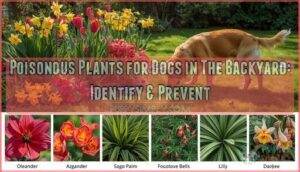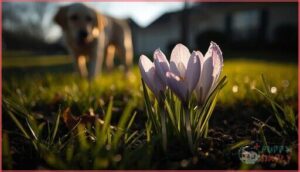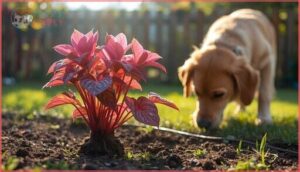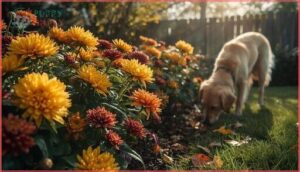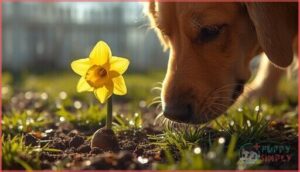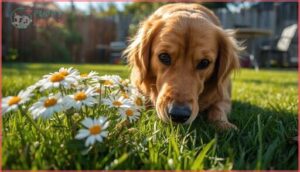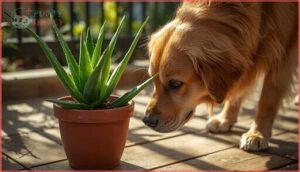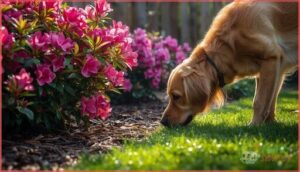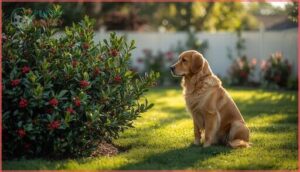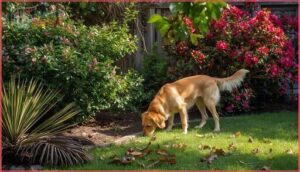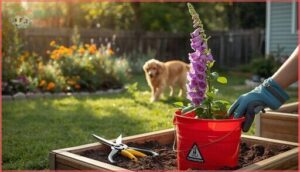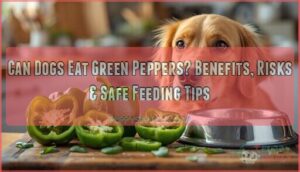This site is supported by our readers. We may earn a commission, at no cost to you, if you purchase through links.
Last spring, a golden retriever named Max nearly died after digging up and chewing daffodil bulbs his owner had planted just days before. The toxins hit his system so fast that he collapsed in the yard within an hour.
Stories like Max’s happen more often than most dog owners realize, and the dangerous plants aren’t exotic specimens—they’re the everyday flowers, shrubs, and trees that make our yards beautiful. Your backyard might look perfectly safe, but common ornamental plants can contain compounds that disrupt your dog’s cellular function, trigger cardiac arrest, or cause severe gastrointestinal damage.
Recognizing which plants pose real threats and understanding what symptoms demand immediate action can mean the difference between a close call and a tragedy.
Table Of Contents
- Key Takeaways
- Common Poisonous Backyard Plants for Dogs
- Toxic Trees and Shrubs Dangerous to Dogs
- Symptoms of Plant Poisoning in Dogs
- Immediate Actions if Your Dog Ingests a Toxic Plant
- Preventing Plant Poisoning in Your Yard
- Frequently Asked Questions (FAQs)
- What is the most toxic plant to dogs?
- Do dogs know to avoid poisonous plants?
- Is there a grass that is poisonous to dogs?
- What weeds are poisonous to dogs?
- What are common symptoms of plant poisoning in dogs?
- How can I protect my dog from toxic plants outdoors?
- Are there any dog-friendly alternatives to toxic plants?
- Can I use pesticides on toxic plants to kill them?
- What should I do if I suspect plant poisoning in dogs?
- Can dogs develop allergies to non-toxic plants?
- Conclusion
Key Takeaways
- Common ornamental plants like daffodil bulbs, azaleas, sago palms, and Japanese yew contain toxins that can cause life-threatening organ failure, cardiac arrest, or gastrointestinal damage even in small amounts—making backyard plant selection a critical safety decision.
- Symptoms of plant poisoning range from immediate oral irritation and drooling (calcium oxalate plants) to delayed multi-organ failure (autumn crocus), with gastrointestinal upset appearing in 63-75% of cases within minutes to four hours after ingestion.
- If your dog eats a toxic plant, contact your vet or Pet Poison Helpline immediately, document which plant parts were consumed and when, and only induce vomiting if instructed—timing matters most within the first hour after ingestion.
- Prevention requires surveying your yard with the ASPCA toxic plant database, physically removing high-risk species entirely (roots and bulbs included), installing secure fencing around garden beds, and replacing dangerous plants with verified safe alternatives like zinnias, rosemary, or spider plants.
Common Poisonous Backyard Plants for Dogs
Your backyard might look harmless, but several common plants can pose serious health risks to your dog. From spring bulbs to popular perennials, these toxic plants can cause anything from mild stomach upset to life-threatening organ failure.
Let’s look at the most common culprits you’ll want to identify and manage in your outdoor space.
Autumn Crocus
Autumn crocus is one of the most poisonous plants you’ll encounter in your backyard. Every part contains colchicine, a powerful toxin that disrupts cell division and can trigger multi-organ failure in your dog. Even small amounts may cause severe vomiting, gastrointestinal bleeding, and diarrhea, with some cases progressing to kidney damage, liver injury, and respiratory failure—often with fatal outcomes.
Other common plants, like Sago Palm, are toxic to dogs and can cause liver failure.
Begonia
Begonia plants, especially their tubers, contain insoluble oxalate crystals that can cause immediate oral irritation when your dog chews them. You’ll notice drooling, pawing at the mouth, and swallowing difficulty. While most begonia varieties produce mild signs, tuber toxicity is more intense because crystals concentrate there. According to the ASPCA’s toxic plant list, begonias are indeed poisonous.
Symptoms include:
- Intense mouth and tongue irritation
- Excessive drooling and lip smacking
- Difficulty swallowing or refusing food
- Vomiting after ingestion
- Visible oral swelling or redness
Contact your vet if these signs appear.
Chrysanthemum
Chrysanthemums and garden mums contain pyrethrins and irritant compounds that cause drooling, vomiting, and diarrhea in dogs. If your dog eats flowers or leaves, incoordination signs may appear within hours.
While pyrethrin toxicity is usually mild, consuming large amounts can intensify symptoms. Keep these popular fall ornamentals out of reach, because even well-behaved dogs occasionally sample toxic plants that look harmless in your yard.
Daffodil
Daffodils rank among the most frequently reported causes of plant poisoning in dogs across North America. The bulb concentration of lycorine and related alkaloids produces severe vomiting, diarrhea, and abdominal pain within 2–24 hours after ingestion. Cardiac effects like arrhythmias and hypotension appear in serious cases. Treatment options include antiemetics, fluid support, and intensive care, so contact your vet immediately if your dog samples any part of these spring favorites.
- Recognize the bulb danger – The underground portion holds the highest toxin concentration
- Watch the ingestion timeline – Symptoms generally develop within 2 to 24 hours
- Monitor for cardiac effects – Irregular heartbeat and low blood pressure signal severe poisoning
- Understand lycorine toxicity – This alkaloid drives the gastrointestinal and cardiovascular signs
- Act fast on treatment options – Early veterinary intervention with supportive care improves outcomes
Daisy
Several daisy varieties contain irritant compounds that trigger vomiting, diarrhea, and drooling when your dog samples leaves or flowers. Daisy toxicity is generally mild, but puppies near patios face higher exposure levels, so remove these ornamentals from high-traffic zones. Safe alternatives like marigold or zinnia offer color without risk. Contact your vet if symptoms persist—treatment options include antiemetics and fluid support to prevent dehydration from plant poisoning after ingestion.
| Daisy Type | Toxic Component | Primary Symptoms |
|---|---|---|
| Garden Mum | Pyrethrins, irritants | Vomiting, incoordination |
| English Daisy | Sesquiterpene lactones | Drooling, diarrhea |
| Shasta Daisy | Pyrethrin-like compounds | Gastrointestinal upset |
| Gerbera Daisy | Generally non-toxic | Minimal to none |
Aloe Vera
Despite its reputation as a healing plant, aloe vera harbors saponin compounds and anthraquinone glycosides that trigger gastrointestinal symptoms when your dog chews the latex-rich leaves. Aloe toxicity from ingestion causes vomiting, diarrhea, and lethargy—sometimes changing urine color. Plant toxicity like this calls for immediate veterinary attention.
- Remove aloe from patios where curious dogs investigate potted plants
- Choose safe alternatives like spider plants or Boston fern for indoor greenery
- Watch for drooling or abdominal discomfort after suspected poisonous plants exposure
Azalea and Rhododendron
Among the most dangerous ornamentals in your yard, azalea and rhododendron species contain grayanotoxins that disrupt cardiac function even in tiny ingestion amounts.
When your dog chews the leaves, grayanotoxin toxicity triggers drooling, vomiting, and diarrhea, followed by neurological effects like tremors and seizures. Breed susceptibility varies, but preventing dog poisoning requires removing these poisonous plants entirely from areas your dog explores.
Holly Varieties
Holly might brighten your winter landscape, but those festive red berries and spiny leaves pose real danger. Holly toxicity stems from saponins that trigger vomiting and diarrhea when your dog samples the berries, while the sharp foliage can physically injure the mouth and digestive tract.
Holiday risk peaks when decorative cuttings land within reach—choose safe alternatives like artificial stems for indoor displays.
Toxic Trees and Shrubs Dangerous to Dogs
Your backyard’s larger plants can pose just as much danger to your dog as smaller flowering varieties. Trees and shrubs often contain toxins in their bark, leaves, nuts, or berries that can cause serious harm when chewed or ingested.
Here are the most common woody plants you’ll want to identify and manage in your outdoor spaces.
Black Walnut
Black walnut trees pose a dual threat to your dog’s safety. Ingestion of the wood causes neurologic signs in 93% of cases, leading to incoordination risks and spontaneous vomiting.
The real danger lies in moldy hulls containing Penitrem A mycotoxin, produced by Penicillium mold. Seasonal exposure peaks in spring when buried nuts become accessible, making vigilant yard checks essential to prevent plant toxicity and dog poisoning from plants.
Chinaberry Tree
Chinaberry toxicity presents a serious risk, with poisoning percentage reaching 56.86% in reported dog cases. Male dogs represent 67.24% of affected animals, with average age at 3.67 years during exposure events.
The fruits and leaves pose particular danger:
- Tremors develop rapidly after ingestion
- Abdominal pain signals gastrointestinal distress
- Weakness progresses without prompt intervention
- Fatal dosage equals 30 g/kg body weight
Plant identification prevents dog poisoning from this ornamental tree.
Fruit Trees (Pits and Seeds)
Your backyard orchard harbors hidden dangers. While stone fruits like plum, apricot, and cherry provide healthy snacks, the pits contain amygdalin that metabolizes into cyanide after your dog’s ingestion. Though single pit quantities pose minimal toxic risk, intestinal blockage becomes your primary concern during high-volume incidents.
| Fruit Type | Toxic Substance | Primary Risk |
|---|---|---|
| Plum/Cherry | Cyanide compounds | Oxygen deprivation |
| Apricot pits | Amygdalin content | Metabolic interference |
| All stone fruits | Physical obstruction | Intestinal blockage |
Consider safe alternatives when landscaping around dogs.
Horse Chestnut
Another widespread danger comes from horse chestnut trees, with the UK alone reporting 470,000 specimens in its 2018 inventory. These ornamental trees produce spiny seed casings called conkers that attract curious dogs. While aesculin toxicity requires ingesting several conkers to trigger symptoms, the greater immediate threat involves choking and intestinal obstruction.
Watch for these warning signs:
- Persistent vomiting and watery diarrhea
- Visible tremors or muscle twitching
- Excessive drooling or oral discomfort
- Abdominal pain with reluctance to move
Treatment options generally involve supportive care, with recovery timelines spanning several days under veterinary supervision.
Japanese Yew
While conkers can sicken your dog, Japanese yew represents a far deadlier threat. This evergreen shrub contains taxine alkaloids throughout its needles and seeds, with just 30 grams proving lethal—roughly 0.1% of your dog’s body weight. The ASPCA lists yew among 415 toxic plants because it triggers rapid cardiac arrest, often within hours of ingestion.
Japanese yew is far deadlier than conkers, triggering rapid cardiac arrest with just 30 grams—roughly 0.1% of your dog’s body weight
| Yew Identification Feature | Risk Factor |
|---|---|
| Dark green needle-like leaves | Contains taxine alkaloids |
| Red berry-like arils | Seeds inside are lethal |
| Common in landscaping borders | High accessibility to dogs |
| Year-round foliage | Constant poisoning timeline risk |
| Resembles harmless evergreens | Easy misidentification by owners |
If your dog consumes any yew material, contact your veterinarian immediately—there’s virtually no margin for error with this plant’s lethal dose and compressed poisoning timeline.
Ivy
Ivy foliage climbs fences and trees throughout yards, but its leaves trigger excessive salivation, vomiting, and breathing difficulties when your dog chews them. Identifying ivy means spotting those characteristic three-to-five-lobed leaves and woody vines—exposure routes include direct plant ingestion or contact with broken stems.
If your dog shows symptoms of plant poisoning from plants like ivy toxicity, treatment options involve immediate veterinary care, though safe alternatives like Boston fern offer worry-free greenery.
Hydrangea
Hydrangea’s showy blooms hide cyanogenic compounds that metabolize into cyanide, reducing oxygen delivery when your dog nibbles leaves or flowers. Hydrangea toxicity triggers lethargy, diarrhea, and vomiting within hours of ingestion.
Identifying these shrubs means recognizing their large, clustered blossoms and serrated leaves—planting safe alternatives like camellia instead protects your dog from toxic plants in gardens while maintaining visual appeal.
Symptoms of Plant Poisoning in Dogs
When your dog eats something toxic in the yard, the signs can show up anywhere from minutes to several hours later, depending on what they ingested. Some symptoms are obvious and immediate, while others develop more slowly and can be easy to miss at first.
Knowing what to watch for helps you act quickly and get your dog the care they need before things get worse.
Gastrointestinal Upset (Vomiting, Diarrhea)
Vomiting and diarrhea are your dog’s first alarm bells after plant ingestion. Between 63% and 75% of dogs with plant poisoning show gastrointestinal upset within minutes to four hours. Watch for:
- Repeated vomiting or retching
- Watery or bloody diarrhea
- Reduced appetite or refusing food
- Abdominal pain or discomfort
- Signs of dehydration (dry gums, lethargy)
These symptoms signal direct irritation from specific toxins, and severity factors include the amount consumed and your dog’s size.
Drooling and Oral Irritation
When your dog chews plants containing calcium oxalates—common in aroids and many ornamental bulbs—you’ll notice immediate pawing at the mouth and heavy drooling. These toxic plants cause oral erythema, swelling, and burning pain within minutes.
Aroid toxicity triggers hypersalivation so severe your dog may frantically paw its face. Recognizing these symptoms of plant toxicity early helps you act before drooling escalates into vomiting or difficulty swallowing.
Lethargy and Weakness
Lethargy and muscle weakness often signal systemic toxicosis taking hold. Between 63% and 75% of dogs with plant toxicity show these signs alongside vomiting, as toxins circulate through the body.
You’ll notice plant-induced fatigue, tremors, or ataxia within hours of ingestion. Neurologic depression can escalate quickly—some dog poisoning symptoms progress to seizures or collapse within 24 hours, demanding immediate veterinary intervention for delayed recovery.
Respiratory Distress
Trouble breathing can signal that toxic plants in gardens have escalated beyond the gut. When your dog shows respiratory distress, immediate veterinary care becomes critical:
- Breathing difficulty or increased respiratory rate may appear as plant toxicity and dogs’ systemic responses worsen.
- Cyanosis (bluish gums) indicates severe oxygen deprivation requiring oxygen therapy.
- Aspiration pneumonia can develop if vomiting leads to inhaled material.
- Lung damage from certain toxins progresses rapidly, preventing dog poisoning starts with plant removal.
Cardiac Effects (Arrhythmias, Abnormal Heart Rate)
When your dog’s heart starts racing or slowing unpredictably after plant ingestion, cardiac glycosides may be attacking the electrical system. Foxglove and oleander produce life-threatening arrhythmias, heart block, and pulse weakness within hours.
You’ll notice tachycardia, bradycardia, or collapse as cardiac failure progresses. These heart irregularities demand emergency intervention—cardiac effects of plants can turn fatal fast.
Immediate Actions if Your Dog Ingests a Toxic Plant
When your dog eats something they shouldn’t have, the next few minutes matter. Your response can make a real difference in the outcome, but only if you know the right steps to take.
Here’s what you need to do immediately if you suspect plant poisoning.
Contacting Your Veterinarian or Poison Helpline
At the first sign of trouble, contact your vet or animal poison control immediately—time matters. Don’t wait—prompt veterinary attention can save your dog’s life.
The Pet Poison Helpline (855-764-7661) charges $89 per incident, including veterinary follow-up and remote triage. ASPCA’s hotline (888-426-4435) operates 24/7 for after-hours care. Both services provide emergency veterinary care guidance within minutes, with hotline response times averaging one call every 70 seconds.
Identifying The Suspected Plant
While waiting for help, gather as much information as possible about the suspect plant. Collecting a plant sample—leaves, stems, flowers—greatly improves diagnostic accuracy in over 60% of cases.
Snap 3–5 clear photographs from different angles, including a scale reference like a coin. Use identification apps to get a preliminary match, then cross‑check against ASPCA’s toxic plant database.
Document which parts your dog ate, the estimated quantity, and when exposure occurred.
Monitoring and Documenting Symptoms
Once you’ve identified the suspect plant, your next priority is tracking what happens. Symptom onset varies widely—some toxins trigger vomiting within 30 minutes, others hide for days.
Monitor health signs every hour, recording what you see:
- Heart rate (normal resting is around 60–140 beats/minute for adult dogs)
- Breathing rate (watch for sustained rates above 40 breaths/minute)
- Gum color and refill time (pale gums or sluggish capillary refill suggest trouble)
Note neuro signs like tremors or disorientation, any cardio changes such as irregular pulse, and gastrointestinal episodes—frequency, appearance, timing. This information capture gives professionals the clearest picture and speeds treatment decisions.
When to Induce Vomiting (and When Not To)
Timing matters. Emesis works best within the first hour after ingestion—after that, most material moves past the stomach and vomiting loses its punch.
| When to Induce | When NOT to Induce |
|---|---|
| Conscious, alert dog within 1–2 hours of ingestion | Already vomiting or showing neurological signs |
| Known toxic plant, no caustic or petroleum content | Ingested caustic substances, acids, or hydrocarbons |
| Vet instructs hydrogen peroxide use at home | Seizures, tremors, lethargy, or respiratory distress |
Never induce at home without calling your vet first—hydrogen peroxide can backfire if your dog’s already compromised.
Professional emesis with apomorphine offers safer, faster results when time and condition allow.
What Information to Provide to Professionals
When contacting your vet or poison control, start with the plant’s name, including both its common and botanical names if known, and specify which part your dog ingested: leaf, bulb, seed, or stem. Note the timing of ingestion, the amount consumed, and your dog’s weight. Describe any observed symptoms, such as vomiting or drooling. Ensure you have your contact details and your dog’s medical background ready when you make the call.
Preventing Plant Poisoning in Your Yard
Keeping your dog safe from plant poisoning starts long before an emergency happens. The best defense is prevention, and that means taking deliberate steps to make your yard safer.
Here are five practical strategies that’ll help you create a dog-friendly outdoor space and minimize the risks lurking in your landscape.
Surveying and Removing Toxic Plants
Start your yard survey by walking every corner with a reference list in hand—the ASPCA’s toxic plant database is excellent for identifying poisonous plants. Prioritize plant removal for high-risk species like Autumn Crocus and azaleas, digging up roots and bulbs completely.
If you’re uncertain about garden plants or safe disposal methods, don’t hesitate to consult a professional landscaper. Preventing dog poisoning begins with this thorough assessment.
Restricting Dog Access to Dangerous Areas
Beyond removing toxic plants, physical barriers are your strongest tool for preventing pet poisoning. Install secure fencing—at least five feet high—around garden beds containing hazardous species or chemical hazards.
Create safe dog zones within your yard where outdoor safety for dogs is guaranteed, and supervise access to unrestricted areas.
Regularly check fence integrity to maintain backyard safety, because even small gaps compromise these preventative measures for garden safety.
Choosing Dog-Safe Plants for Landscaping
Selecting safe plants means trading risk for beauty without compromise. Non-toxic alternatives like zinnias, sunflowers, and snapdragons deliver color, while rosemary and basil add fragrance—all verified as safe by the ASPCA database.
Pet-friendly landscaping requires research before planting; consult trusted resources to confirm safety for your breed and yard. Smart garden design tips prioritize dog health and safety through preventative measures, turning safe gardening practices into second nature.
Supervising Dogs Outdoors
Constant visual monitoring transforms your yard from risk zone to safe haven—plants account for 8.1% of pet poison exposures annually, but supervision slashes those numbers. Here’s your outdoor safety protocol:
- Keep dogs within eyesight during all yard activities
- Use leash training for reactive or curious breeds
- Conduct daily yard checks for new vegetation
- Watch puppy supervision closely—they explore mouth-first
- Practice active monitoring near unfamiliar plants
Preventing dog poisoning starts with your presence.
Keeping Emergency Contacts Handy
When seconds count, fumbling for phone numbers costs lives. Store your vet’s contact, the nearest emergency vet, and the Pet Poison Helpline (855-764-7661) in your phone’s favorites and on a printed card in your wallet. Digital storage fails when batteries die.
For travel preparation, add local emergency veterinary care contacts before you leave. Helpline availability means 24/7 access to animal poison control expertise when you need it most.
Frequently Asked Questions (FAQs)
What is the most toxic plant to dogs?
Among toxic plants, the sago palm stands alone as the deadliest for dogs. Ingesting even one seed can trigger liver failure, with mortality rates reaching 50% despite aggressive treatment options.
Do dogs know to avoid poisonous plants?
Unfortunately, dogs don’t possess innate avoidance of toxic plants. Domestication effects have weakened their natural foraging instincts, meaning pet safety depends on learning influence, sensory cues, and your management—not their ability to recognize plant toxicity or dog poisoning risks.
Is there a grass that is poisonous to dogs?
Most lawn grasses aren’t toxic to dogs, but ornamental pampas grass and grass palm can cause vomiting or seizures.
Grass awn dangers from foxtails pose mechanical injury risks, requiring prompt removal.
What weeds are poisonous to dogs?
Buttercups, dandelions, and nightshade species top the list of toxic weed ID threats in your garden.
These weedy invaders contain alkaloids and ranunculin, causing vomiting, tremors, and cardiac effects when dogs investigate them.
What are common symptoms of plant poisoning in dogs?
Gastrointestinal signs like vomiting and diarrhea appear first, often within hours. You’ll notice oral irritation, drooling, lethargy, and weakness.
Severe cases bring respiratory distress, cardiac abnormalities, tremors, or neurologic signs requiring immediate veterinary attention.
How can I protect my dog from toxic plants outdoors?
You can protect your dog from toxic plants through safe landscaping choices, supervised playtime, plant identification training, keeping emergency contacts ready, and using training redirection to prevent chewing on dangerous garden vegetation.
Are there any dog-friendly alternatives to toxic plants?
You can swap toxic plants for safer options that bring the same beauty—think rosemary instead of oleander, spider plants replacing ivy, or vibrant orchids standing in for daffodils. Non-toxic landscaping protects your dog without sacrificing style.
Can I use pesticides on toxic plants to kill them?
You can use pesticides, but they pose serious dog poisoning risks through residue exposure. Safe alternatives like manual removal or pet-friendly herbicides are better.
Always follow application timing guidelines and seek professional advice for garden plants.
What should I do if I suspect plant poisoning in dogs?
Time is of the essence—contact your vet or the Pet Poison Helpline immediately.
Prioritize plant identification, symptom monitoring, and documenting ingestion details.
Avoid inducing vomiting without professional guidance to prevent worsening your dog’s condition.
Can dogs develop allergies to non-toxic plants?
Yes, dogs can develop pollen allergies and contact dermatitis from non-toxic plants. Seasonal allergies affect 3–15% of dogs worldwide, causing itching and skin issues. Breed predispositions exist, making allergy testing valuable for affected pet health.
Conclusion
Think of your yard as a medieval apothecary—beautiful but deceptively dangerous. Recognizing poisonous plants for dogs in the backyard isn’t about memorizing every botanical toxin; it’s about knowing which common species pose real threats and acting decisively when exposure occurs.
Survey your landscape, restrict access to high-risk zones, and keep emergency contacts within reach. Your vigilance transforms a potentially lethal environment into one where your dog can explore safely.
- https://pmc.ncbi.nlm.nih.gov/articles/PMC10467095/
- https://www.petmd.com/dog/poisons/plants-poisonous-to-dogs
- https://www.guidedogs.org.uk/getting-support/information-and-advice/dog-care-and-welfare/dog-poisons-outside/
- https://www.akc.org/expert-advice/home-living/poisonous-plants-for-dogs/
- https://pawpartnersunleashed.org/resources/pet-safety/hazardous-plants-to-pets/

